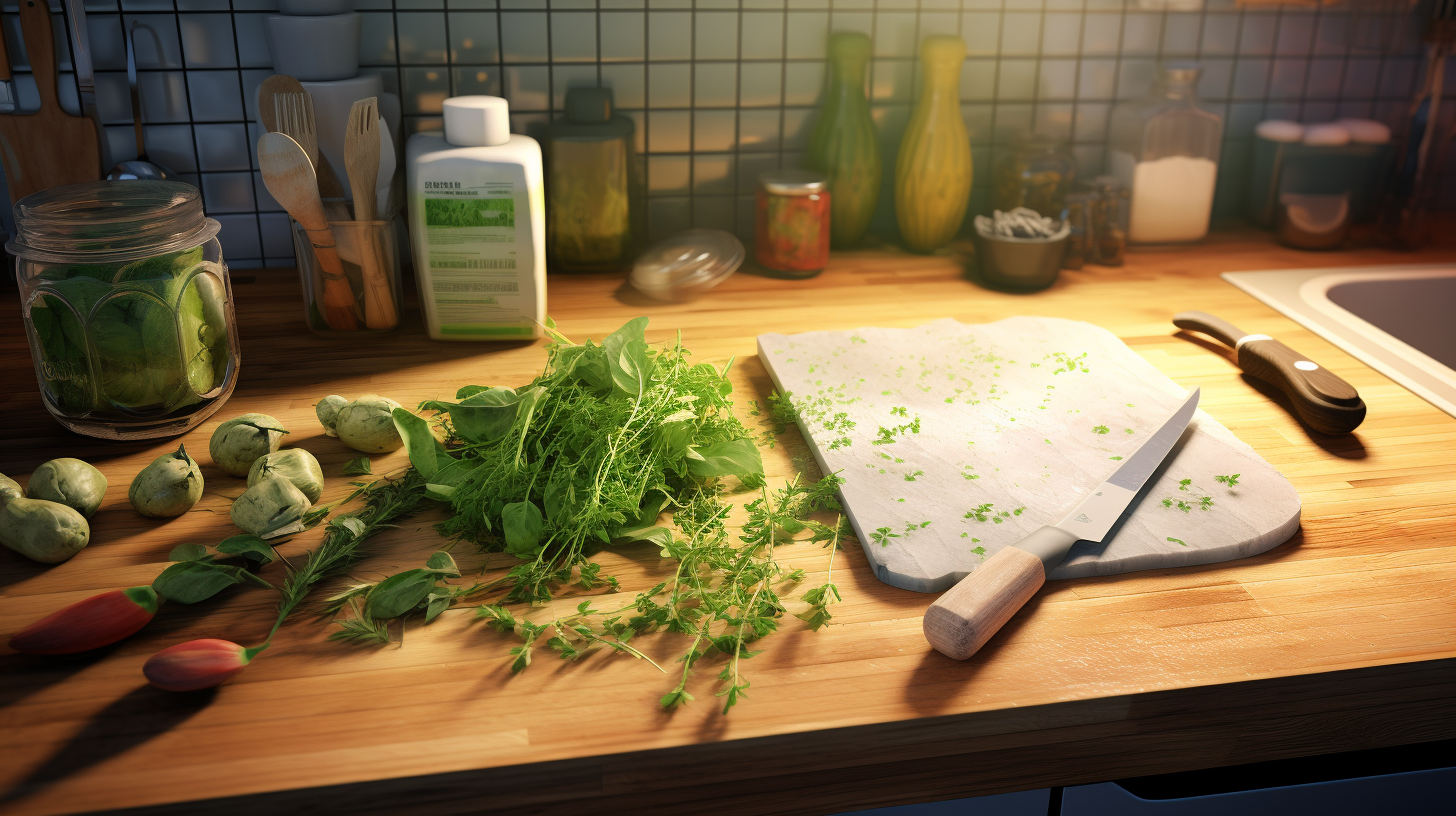You’re probably familiar with the struggle of fresh herbs wilting within days of buying them. But fear not, because freezing herbs is an easy solution to make them last longer and retain their flavor. In this article, you will discover simple yet effective techniques on how to freeze herbs, ensuring that you have a ready supply of flavorful herbs at your disposal throughout the year. Whether you’re an aspiring chef or simply love adding a touch of freshness to your meals, freezing herbs is a game-changer that you won’t want to miss. Say goodbye to wasted herbs and hello to endless culinary possibilities!
Choosing Herbs
When it comes to choosing herbs, fresh is always best! Look for herbs that are vibrant in color, with no signs of wilting or discoloration. Trust your nose – herbs should have a strong, aromatic scent. This indicates that they are at their peak freshness and flavor. If you have the opportunity, try to pick herbs from your own garden or buy them directly from a local farmer’s market. These herbs are likely to be the freshest and will give your dishes a burst of flavor.
Another important consideration when choosing herbs is quantity. How much do you need for your recipes? Keep in mind that fresh herbs tend to lose some of their volume when frozen. As a general rule of thumb, if a recipe calls for one tablespoon of fresh herbs, you’ll want to freeze about one teaspoon of chopped herbs. This will help you achieve the perfect balance of flavors when using your frozen herbs later on.
Preparing the Herbs
Before freezing your herbs, it’s crucial to properly prepare them. Start by washing your herbs to remove any dirt or debris. Fill a bowl with cold water and gently swish the herbs around to loosen any dirt. You can also use a colander for this step, making sure to handle the herbs with care. Remember not to chop the herbs before washing, as this can cause them to lose some of their flavor.
Once your herbs are clean, it’s time to dry them thoroughly. Excess moisture can lead to freezer burn, so it’s important to ensure that they are completely dry before freezing. You can use a salad spinner or gently pat them dry with paper towels. If you’re in a hurry, laying the herbs out on a clean kitchen towel and allowing them to air dry can also be effective.
Freezing Methods
There are several different methods you can use to freeze your herbs, depending on your preferences and the type of herbs you have.
Using ice cube trays
One popular method is to freeze your herbs in ice cube trays. Start by chopping your herbs to the desired consistency. Place a small amount of chopped herbs into each compartment of the ice cube tray, filling them about halfway. Next, carefully pour water or olive oil over the herbs, making sure they are fully submerged. Pop the tray into the freezer for a few hours, or until the herbs are completely frozen. Once frozen, transfer the herb cubes to a freezer-safe bag or container, making sure to label them with the name of the herb and the date.
Making herb-infused oil cubes
If you prefer to freeze your herbs in oil, you can make herb-infused oil cubes. Simply chop your herbs and place them in the compartments of an ice cube tray, filling them about halfway. Then, pour olive oil over the herbs, making sure they are covered. Freeze the tray until the oil is solid, then transfer the cubes to a freezer-safe bag or container.
Blanching and freezing
Blanching is a method that involves briefly boiling the herbs before freezing them. Start by preparing a pot of boiling water and a bowl of ice water. Submerge the herbs in the boiling water for about 30 seconds, then transfer them to the ice water to cool down quickly. Once they are cool, pat them dry and place them in a freezer-safe bag or container. Blanching helps to preserve the color and flavor of the herbs.
Flash freezing
Flash freezing is a quick freezing method that is ideal for delicate herbs like basil or mint. Start by placing the herbs on a baking sheet in a single layer. Place the baking sheet into the freezer for about 30 minutes, or until the herbs are frozen solid. Once frozen, transfer them to a freezer-safe bag or container.
Freezing Whole Leaves
If you prefer to freeze your herbs in their whole leaf form, there are a few steps you should take to ensure they freeze properly.
Pre-freezing treatment
Start by removing any damaged or discolored leaves from the bunch. Next, blanch the herbs by submerging them in boiling water for about 30 seconds, then transferring them to ice water. Once they are cool, pat them dry and place them on a baking sheet in a single layer. Freeze the herbs for about 30 minutes, or until they are solid.
Packaging the herbs properly
Once your whole leaves are frozen, transfer them to a freezer-safe bag or container. It’s important to remove as much air as possible from the packaging to prevent freezer burn. You can either use a vacuum sealer or manually press out the air before sealing the bag or container. Don’t forget to label the packaging with the name of the herb and the date.
Freezing Chopped Herbs
Chopping your herbs before freezing them can make them more convenient to use in recipes later on. Here’s how to freeze chopped herbs:
Blanching the herbs
Start by blanching the herbs to preserve their flavor and color. Submerge the chopped herbs in boiling water for about 30 seconds, then transfer them to ice water to cool down quickly. Once they are cool, drain the herbs and gently pat them dry with paper towels.
Chopping the herbs to desired consistency
If you haven’t already, chop the herbs to the desired consistency. Keep in mind that finely chopped herbs will distribute their flavor more evenly in dishes, while larger pieces can provide a more prominent taste. Choose the chopping method that suits your culinary preferences.
Packaging the chopped herbs
Once the chopped herbs are dry, portion them into freezer-safe bags or containers. For convenience, you can measure them into pre-portioned amounts that you typically use in recipes. Label the packaging with the name of the herb and the date, then place them in the freezer.
Freezing Pesto
Pesto is a versatile sauce that can be used in a variety of dishes, making it a great candidate for freezing. Here’s how to freeze pesto properly:
Preparing the pesto
Start by making your pesto according to your favorite recipe. You can use traditional basil pesto or get creative with other herb combinations like cilantro and mint. Blend the ingredients until you have a smooth and creamy sauce.
Portioning the pesto
To make pesto easier to use later on, consider portioning it into smaller servings. You can use ice cube trays or small containers for this step. Fill each compartment or container with your desired amount of pesto, leaving a small space at the top to allow for expansion during freezing.
Freezing the pesto
Place the pesto-filled compartments or containers in the freezer and allow them to freeze completely. Once frozen, transfer the pesto cubes or containers to a freezer-safe bag or container. Don’t forget to label the packaging with the name of the pesto and the date.
Freezing Herb-Infused Oils
If you enjoy the flavors of herb-infused oils, you can freeze them to keep them fresh for longer. Here’s how to do it:
Preparing the herb-infused oil
Start by infusing your oil with your chosen herbs. You can use a variety of herbs like rosemary, thyme, or garlic. Simply place the herbs in a bottle or jar and cover them with the oil. Allow the herbs to infuse for at least a day before using the oil.
Portioning the oil
To make it easy to use the herb-infused oil later on, consider portioning it into smaller servings. You can use ice cube trays or small containers for this step. Fill each compartment or container with your desired amount of oil, leaving a small space at the top to allow for expansion during freezing.
Freezing the oil
Place the oil-filled compartments or containers in the freezer and allow them to freeze completely. Once frozen, transfer the oil cubes or containers to a freezer-safe bag or container. Remember to label the packaging with the type of oil and the date.
Freezing Herb Butter
Herb butter is a delicious addition to many dishes and can be frozen to save for later. Here’s how to freeze herb butter properly:
Preparing the herb butter
Start by making your herb butter by blending fresh herbs into softened butter. You can use a variety of herbs like parsley, chives, or dill. Be creative and experiment with different combinations to find your favorite flavors.
Portioning the butter
To make herb butter easier to use later on, consider portioning it into smaller servings. You can shape the butter into small logs or use ice cube trays for individual portions. Wrap each portion tightly in plastic wrap or place it in a small container.
Freezing the herb butter
Place the wrapped herb butter portions or the butter-filled compartments in the freezer and allow them to freeze completely. Once frozen, transfer the portions or butter cubes to a freezer-safe bag or container. Don’t forget to label the packaging with the type of herb butter and the date.
Labeling and Storing
Proper labeling and storage are essential for keeping your frozen herbs fresh and organized.
Labeling the frozen herbs
To avoid confusion and ensure you grab the right herb every time, it’s important to label your frozen herbs. Use a permanent marker or labels to clearly indicate the name of the herb and the date it was frozen.
Choosing appropriate storage containers
When it comes to storing your frozen herbs, opt for freezer-safe bags or airtight containers. Make sure the containers are specifically designed to withstand low temperatures and prevent freezer burn. Vacuum-sealed bags or containers can also help maintain the quality of your herbs.
Storing in the freezer
When storing your frozen herbs, keep them in a designated area of your freezer. This will make it easier to locate them later on. Try to keep them away from the walls and door of the freezer, as these areas tend to experience temperature fluctuations. Instead, store them towards the back or in a dedicated freezer drawer.
Thawing and Using Frozen Herbs
When you’re ready to use your frozen herbs, there are a few thawing methods to consider.
Thawing methods
One method is to simply remove the desired portion of frozen herbs from the freezer and let them thaw in the refrigerator. This can take several hours or overnight, depending on the quantity and size of the herbs.
If you’re in a hurry, you can also thaw the herbs by placing them in a bowl of cool water. Change the water every 10-15 minutes until the herbs have thawed completely.
Using frozen herbs
Once thawed, frozen herbs can be used in a variety of dishes. Keep in mind that frozen herbs may have a slightly different texture compared to fresh ones, but they will still add a burst of flavor to your recipes. Use them in soups, stews, sauces, marinades, or sprinkle them over finished dishes as a garnish.
Now that you know how to freeze herbs properly, you can enjoy the flavors of fresh herbs all year round. Whether you’re preserving herbs from your garden or taking advantage of a great sale at the store, freezing herbs is a convenient and effective way to keep them at their best. So go ahead, stock up on your favorite herbs, and start freezing!

